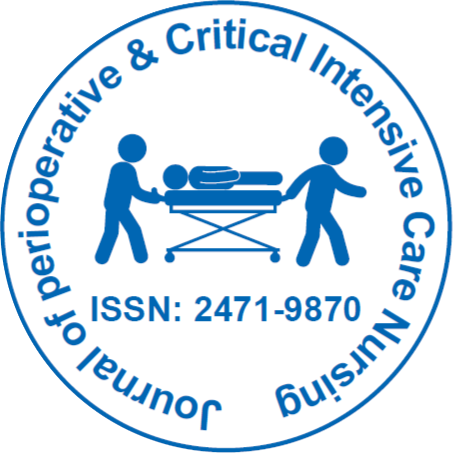
Journal of Perioperative & Critical Intensive Care Nursing
Open Access
ISSN: 2471-9870
+44-77-2385-9429

ISSN: 2471-9870
+44-77-2385-9429
Perspective - (2024)Volume 10, Issue 2
Surgical procedures have evolved significantly over the decades, driven by technological advancements, improved understanding of anatomy and pathology, and refined surgical techniques. These developments have revolutionized healthcare by offering safer, more precise interventions that reduce recovery times and improve patient outcomes. This article discusses about key advancement in surgical procedures, highlighting their impact on patient care and recovery.
Minimally invasive surgery
One of the most significant advancements in surgery is the widespread adoption of minimally invasive techniques. These procedures utilize small incisions, specialized instruments, and advanced imaging technology (such as laparoscopy and robotic surgery) to perform complex surgeries with minimal disruption to surrounding tissues. Benefits include less discomfort following surgery, less time spent in the hospital, quicker recuperation, and a decreased risk of problems including blood loss and wound infections. For instance, laparoscopic cholecystectomy to remove the gallbladder and robotically assisted prostatectomies operations have developed into customs because of its effectiveness and advantages for patients. Surgeons can operate with extreme dexterity and precision, improving surgical results and patient contentment.
Advancements in imaging and navigation
The integration of advanced imaging modalities, such as Computed Tomography (CT), Magnetic Resonance Imaging (MRI), and intraoperative ultrasound, has transformed surgical planning and intraoperative navigation. Surgeons can precisely plan surgical approaches, see anatomical components in detail, and foresee any problems with preoperative imaging difficulties. Real-time imaging and navigation during surgery. Systems offer improved guidance and visualisation, making surgeons to carry out operations more securely and accurately. These tools are especially useful for intricate surgical procedures involves fragile constructions or challenging-to-reach locations, like spinal operations or brain surgery.
Robotics in surgery
Robotic-assisted surgery represents another significant leap forward in surgical innovation. Advanced robotics, computer technology, and high-definition imaging are combined in robotic systems, such the Vinci Surgical System (VSS), to allow surgeons to carry out complex operations with more control and precision. The surgeon's hand movements are translated by the robotic platform into surgical instrument movements that are more accurate and smaller, lowering mistakes made by people and enhancing surgical results.Robotic surgery is utilized across various specialties, including urology, gynecology, and cardiothoracic surgery, for procedures ranging from prostatectomies to hysterectomies. Its benefits include shorter recovery times, reduced trauma to surrounding tissues, and improved cosmoses.
Enhanced recovery protocols
Advancements in surgical techniques are complemented by Enhanced Recovery After Surgery (ERAS) protocols, which optimize perioperative care to accelerate recovery and minimize complications. ERAS protocols incorporate evidence-based practices such as preoperative nutrition optimization, multimodal pain management strategies, early mobilization, and postoperative care pathways customized to individual patient needs. These protocols aim to reduce stress responses to surgery, enhance immune function, and promote faster recovery with fewer postoperative complications. By standardizing care practices and focusing on patient-centered outcomes, ERAS protocols contribute to improved surgical outcomes and patient satisfaction.
Challenges and future directions
While advancements in surgical procedures have significantly improved patient care, challenges remain. These include the cost of adopting new technologies, training healthcare professionals in advanced techniques, and ensuring equitable access to cutting-edge surgical care across different healthcare settings. Future directions in surgical innovation include further integration of Artificial Intelligence (AI) for surgical planning and decision-making, development of more personalized surgical approaches based on genetic and molecular profiling, and advancements in regenerative medicine to support tissue repair and regeneration post-surgery.
Advancements in surgical procedures have transformed the landscape of modern medicine, offering patients safer, more effective treatment options with faster recovery times and improved outcomes. From minimally invasive techniques and advanced imaging to robotic-assisted surgery and enhanced recovery protocols, these innovations underscore the ongoing commitment to advancing surgical care. As technology continues to evolve and healthcare delivery models adapt, the future of surgical procedures holds potential for further improvements in patient care, surgical precision, and overall healthcare outcomes.
Citation: Odhiambi B (2024) Personalized Surgical Care: Cultural Competence in Personalized Healthcare Delivery and Future Directions. J Perioper Crit Intensive Care Nurs. 10:247.
Received: 10-May-2024, Manuscript No. JPCIC-24-32823; Editor assigned: 13-May-2024, Pre QC No. JPCIC-24-32823 (PQ); Reviewed: 27-May-2024, QC No. JPCIC-24-32823; Revised: 03-Jun-2024, Manuscript No. JPCIC-24-32823 (R); Published: 10-Jun-2024 , DOI: 10.35248/2471.9870.24.10.247
Copyright: © 2024 Odhiambi B. This is an open-access article distributed under the terms of the Creative Commons Attribution License, which permits unrestricted use, distribution, and reproduction in any medium, provided the original author and source are credited.